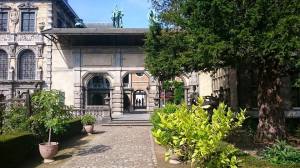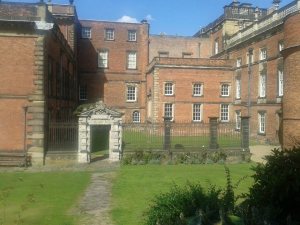I am much involved in a long-term research project on the literature of Renaissance houses and gardens in which I envisage several outcomes. First, I hope to make connections between houses and gardens that Margaret Cavendish (1623 – 1673) might have seen and her published poems, plays, fiction, letters, scientific essays, biography, and autobiography. She was a prolific writer and is today remembered along with Aphra Behn as one of the two great English women writers of the seventeenth century.
Second, I will try to connect house and garden to poems by such writers as Thomas Carew. I especially like his verse letter “To G N from Wrest” (ca 1639), which plays with the meanings that gather around or emanate from a set of garden statues at Wrest Park in England. Ceres and Bacchus are paired, and I am looking for other groupings of classical figures in garden sculpture. I like to go off on tangents in research, so my third objective is less a tangible goal and more a matter of keeping myself and like minded readers entertained with the oddities of literature and its historical backgrounds.
To return to Cavendish, one of the one places that she lived with her husband while he was in exile during the Interregnum was at the Rubens house in Antwerp. The building was let to the Cavendishes by the widow of the painter Peter Paul Rubens. Rubens added the three-storey wing that is shown slightly left of center in the picture above. He also added the gate which is at the center of that image and the one below.
Margaret Cavendish had an interest in gates for large houses like this one and writes about people being “put out at the gates” in one of her plays, ‘The Unnatural Tragedy.’ Gates also can be important in actual English country houses. A gate at Wentworth Woodhouse was singled out for special attention by the guide on the tour that I took in summer of 2014. It was from the Wentworth Woodhouse gate that Thomas Wentworth, First Earl of Strafford, began his journey to be put to death in London in 1641. His family considered him to be a martyr. See the Wentworth Woodhouse gate below.
In any event, I plan to explore how various elements of architecture would have influenced the thinking of Cavendish and her readers. The gate at the Rubens House does not separate the house from the outside world, for it lies between the house and the garden. The Rubens House gate is, rather, mostly an edifice that evokes ancient Rome in the midst of bourgeois Antwerp. It claims a venerable past, a past that is in a sense timeless and immutable. If Cavendish has a gate like this one in mind, then we might understand that the scheming lady’s maid, Nan, who is ejected from the gate in the play is dismissed from ancient civility and not only from a prosperous household. Nan’s mistress, the heartless social-climer Madame Maleteste, eventually leaves this gate behind as well. Comments welcome.
The next blog in this series will be on literary biography and guest books in English and Dutch country houses.
Jim Fitzmaurice



I find the notion of English country houses intriguing. Coming from the States to England, I’m sure it will be a delight to see the houses examined during the course. I’m not sure we have such things as country homes in the States. If we do, I’m unfamiliar with their locations. The notion of the importance of gates is fascinating, yet we often use the term ‘gateway to’ something in reference to entering a new phase or seeing something in a new light. I do recall reading Cavendish and Behn in graduate school. As for Reubens, I just saw his amazing tapestries on exhibit at the J. Paul Getty museum in Los Angeles.
LikeLike